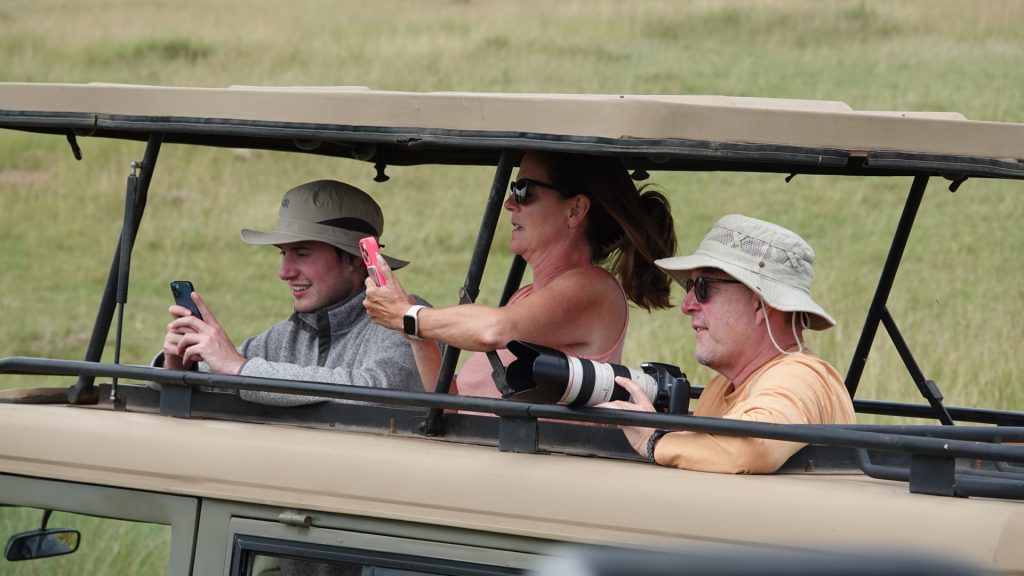 Taking a safari was truly the trip of a lifetime! At this age we are still young and fit to enjoy it and, have the ability to splurge on it to make it a trip of a lifetime.
Taking a safari was truly the trip of a lifetime! At this age we are still young and fit to enjoy it and, have the ability to splurge on it to make it a trip of a lifetime.
I outline everything below and also in this video:
We were blessed to be able to go with our 25-year-old son and experience this together with him. This is a great trip for you to take with your spouse/significant other, young adult kids, and older grandchildren.

We saw many young kids asleep in the vehicles because safari trips are around 6:30 am for the morning ride and 4:30 pm for the evening ride. (It is too hot for the animals to be out during the day, so you have a greater likelihood of seeing them at sunrise and sunset.)
Personally, I would wait until kids are at least older teenagers before taking them on this type of trip. The younger kids don’t appreciate it.
Where Should You Go?
There are so many choices about a safari – Bali, South Africa, Kenya, Tanzania, etc. We chose Kenya and Tanzania – in hopes of seeing the wildebeest migration. Sadly, we missed the big migration (due to weather patterns they shifted), but we did see buffalo and zebras migrating.
Look at your options and see what’s best for you and your family and how you want to travel and what you want to see. Because of the wildebeest migration (which starts in Tanzania) our trip involved going to both Kenya and Tanzania, which are two separate countries and have border crossings and immigration. What we learned as we met people on our trip is that most companies don’t offer this option because of the paperwork and visas that are required for border crossings.
Additionally, there are limited border crossings so you could literally be at your camp in Kenya and you can see Tanzania which is a 5-minute drive but instead, you have to fly to the other side of Kenya, drive for a few hours, cross the border, and go back. That being said, it was worth it to have the long drives and see how people in those countries really live and drive through the towns and villages.
We had one very long travel day, but we left early so the trip to the airport was basically a mini safari and it was there we saw one of the best sites of our trip. I spotted a dead buffalo in the middle of the tall grasses and our guide drove up and said, “The lions have to be near!”
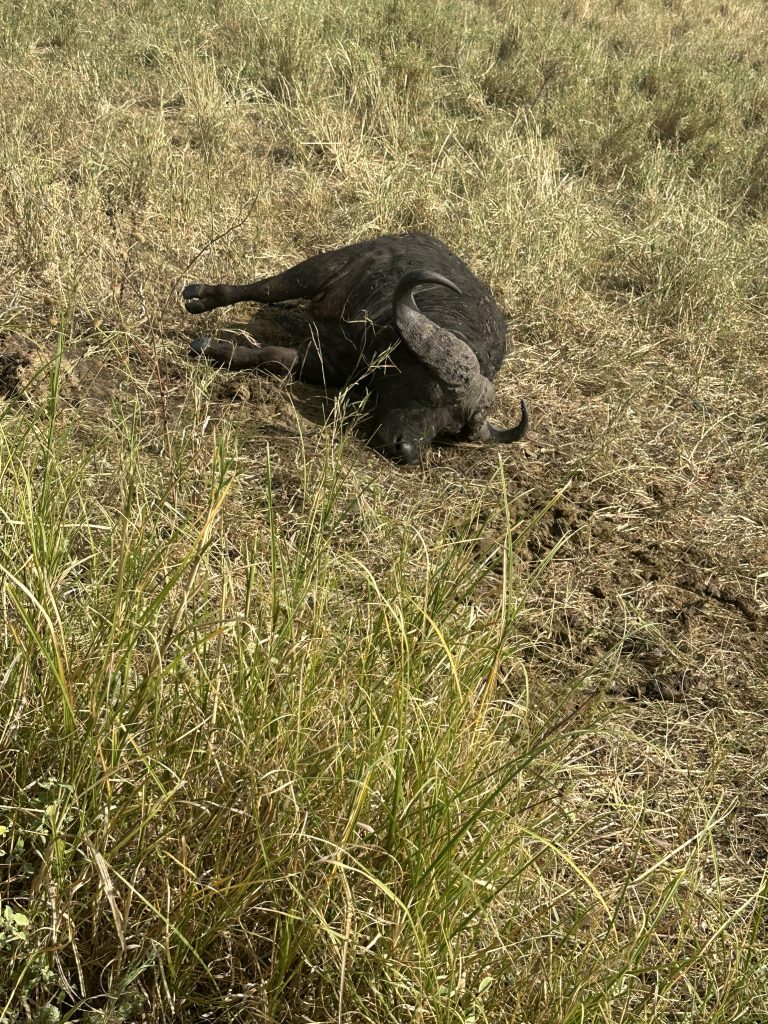
And sure enough, there walked up a lioness to check on her kill. It was unbelievable! Like the guides say, “You’ll see what you’ll see!”
A good travel agent is vital for this and can make anything happen. We used my good friend Jen at Destinations Done Right and I HIGHLY recommend her for not just a safari but any of your travel needs. Jen @ DestinationDoneRight.com
Also, If you go the several camps route like we did, know that travel in Africa is done in small planes and dirt airstrips that are located everywhere. They are like the taxis of Africa. And very important to note… schedules change constantly because they might have to now pick someone else up from another airstrip so be flexible and don’t get stressed over changes. Your tour company will work it out with the plane company and get you to where you are going.
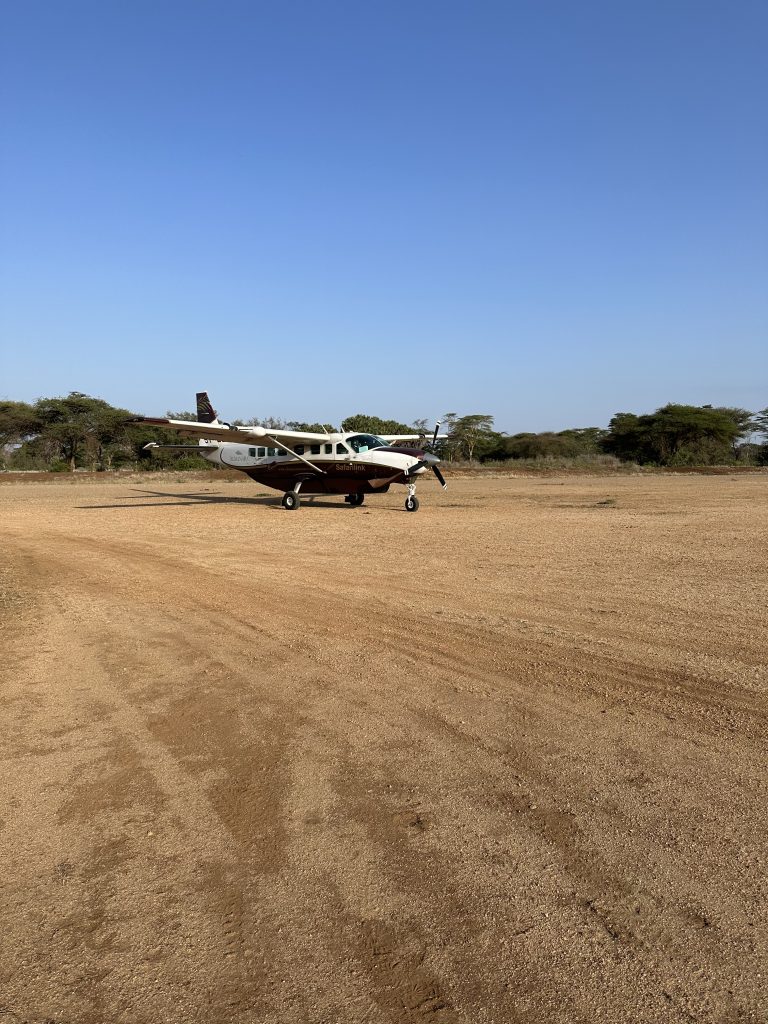
When To Go
We went in late June which is the end of the off-season. For us, this was an ideal time to go. What we learned is that when you go during peak season, it’s packed with tour vehicles. If there is an animal sighting, you only get to stay 5 minutes. We had the parks almost entirely to ourselves and could hang out with the animals and video and take pictures for hours if we wanted to.
We still saw everything you can imagine, and we were up close and personal with all of them. We literally had happy hour with lions (in our vehicle of course), we saw a cheetah, a leopard bringing her prey out of the tree, hundreds of elephants, zebra, giraffe, rhinos, buffalo, and every other animal and bird you can think of.
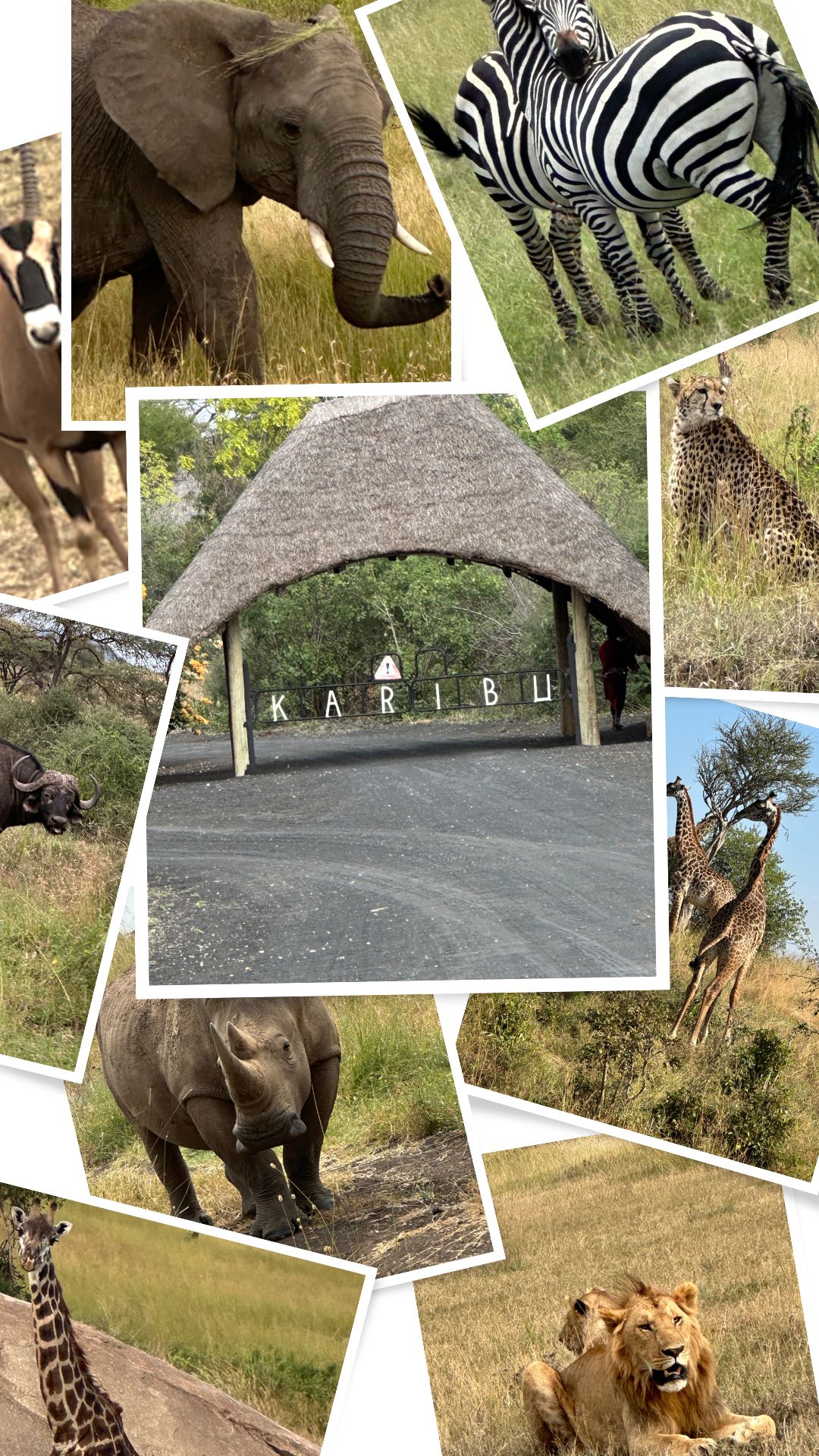
Probably the most memorable part of the trip for me was on our last day. It was a lioness about to give birth and we were feet from her watching her pant and roll around because she was in labor. She was staring in my eyes and I just wanted to go rub her belly and tell her, “I’ve been there.” But of course I didn’t do that!
Remember, going slightly off-season might be a better option. We went the last two weeks in June and it was spectacular.
Vaccines
Let me start by saying I am NOT a doctor nor am I in the medical field. I am just sharing what I learned along the way. My doctor recommended Passport Health, which is located all across the U.S. I did the first visit to check it out. It’s $99 per person for a consult and as long as you get your shots within 30 days, you don’t have to pay for another office visit.
Then, a friend told me Costco does vaccines. It’s $39 for the consult and the vaccines were about half the price of Passport Health. Caveat – Costco only offers this in certain states. We were able to do it in Virginia, but our son had to use Passport Health in New York.


Also, depending on where you are staying you can make your decision about malaria pills. Since we were earlier in the season and at a higher elevation, we opted not to but that is a personal decision.
The Yellow Fever vaccine was the only required one to go to Africa and make sure you get your yellow card. They did not give it to our son and he had to go back to Passport Health to get it. You will definitely need it if you go to Africa.
Also, if you are over 60, consult with your doctor as there are some vaccines they don’t want you to do at that age.
How to Get There?
We splurged on this trip and chose to try out the Emirates Airbus A380 from Dulles to Nairobi with a stop in Dubai. Our son who traveled with us had this plane on his bucket list and my thought was, “There is no way my 25-year-old son is flying in that plane on business class and I’m in the back.”

It was truly an experience from the minute you head out your door. They have a car service there to pick you up and deliver you to the airport. We flew out of Dulles so the lounge was a shared lounge, but our son got to experience the full Emirates experience out of JFK.
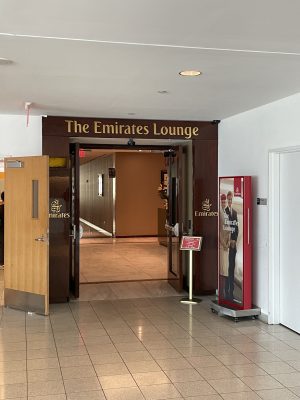
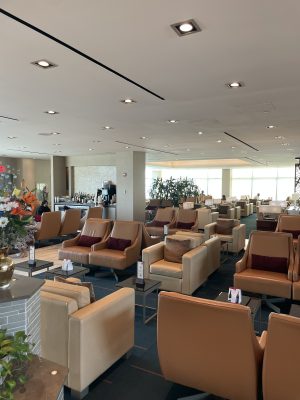
They board you on the plane exclusive to your section, so we took a private tunnel into business class. The pods alone are spectacular with a seat that reclines fully to a bed (they bring you a separate mattress).
The entertainment system has 5,000 options from movies, to documentaries, to podcasts, to live news, and more (how do you choose?). They have USB plugs to keep everything charged. Make sure you bring your adapter on board with you if you need to charge a laptop.
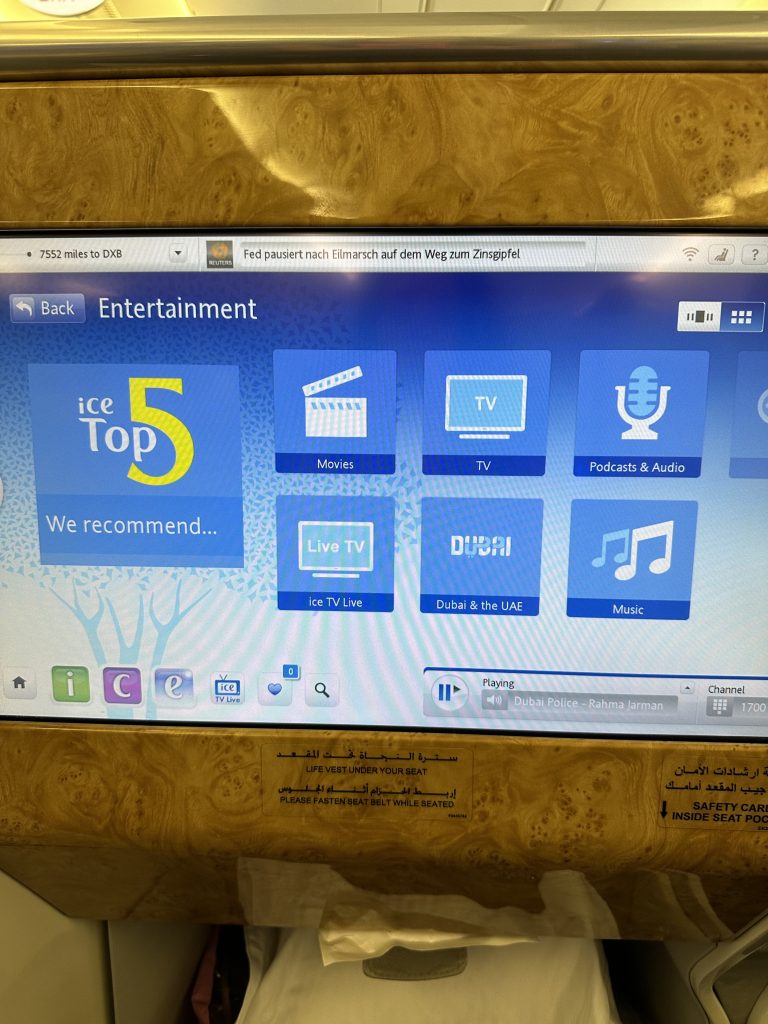
The coolest thing is the cameras on the plane so you can watch take-off and landing.
The minute you sit down you are greeted with a glass of juice or champagne in a glass and meals are served on chinaware with silverware and a white tablecloth. The food and wine were delicious, and we were pampered throughout the entire 13-hour flight. They also have a separate bar in the back if you want to take a break and go sit and relax and have a drink. And the nicest touch of all is the flower vases on the wall indicating where the restroom is.
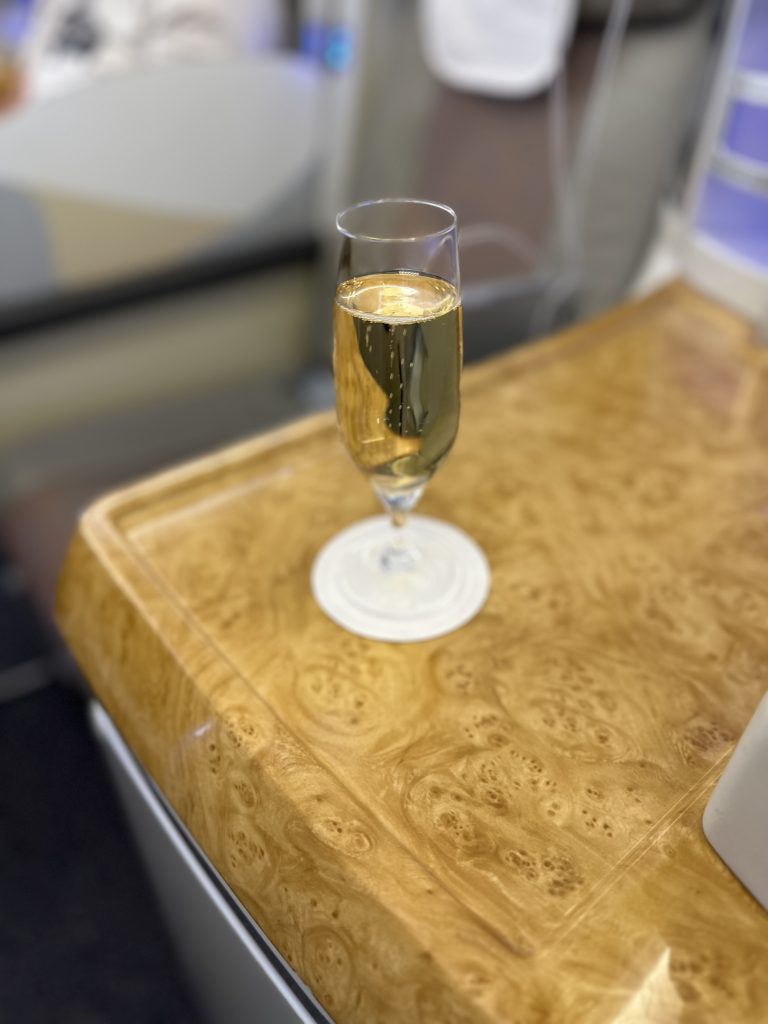
We also were gifted Bulgari travel kits designed for men or women with all the essentials. The only downside… it adds to your weight a bit, but that bag is a keeper!

We landed in Dubai and experienced the Emirates lounge there which was a full spread of amazing food and desserts, anything you want to drink non-alcoholic or alcoholic, plugs galore, and comfy leather seating.
Many airlines fly you direct to Nairobi or connect you there like we did through Dubai. My big recommendation is if you are able to fly business or first class in a seat that reclines to a bed, do that. We were able to sleep a little on each of the flights and weren’t impacted by any jet lag by getting about 3 hours on each flight.
The way back is in the middle of the night and we slept quite a bit.
NOTE about Duty-Free purchases coming home: I bought duty-free wine in Nairobi and although we were through the main security when we landed in Dubai, they would not let me take it on the plane saying the U.S. government says any flight bound for the U.S. cannot have liquid brought onboard. They even made us get rid of our water bottles from the Emirates lounge.
Types of Lodges
You really want to plan if you want to go rustic or glamping. We did a mix of both with two camps more glamping, one more rustic, and one all-out luxury glamping. I loved the camp of our rustic lodge, but the twin bed/cot left a lot to be desired, especially when I woke up and had to get up out of it. The glamping was still canvas tents, but it was upscaled with luxury bedding and a beautiful bathroom/dressing area. Some of our camps offered family tents and that was fun to have a ton of bonding with our son. Not sure how many more opportunities we’ll have like this.
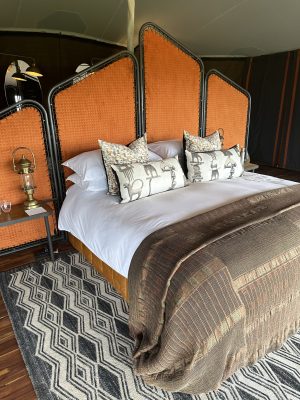
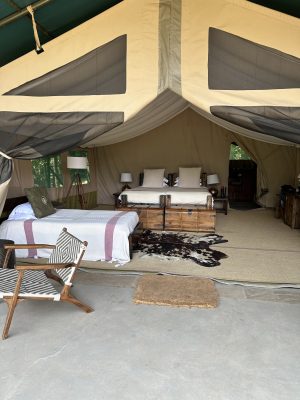
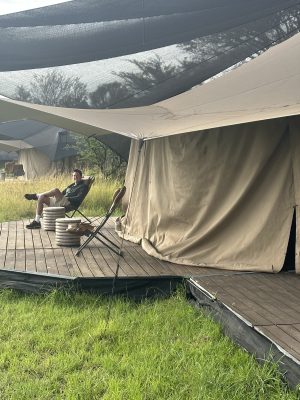

We chose to do four camps to see as many different places as we could. I am glad we did this because if you stayed in the same camp the entire time, you might be limited in what you see.
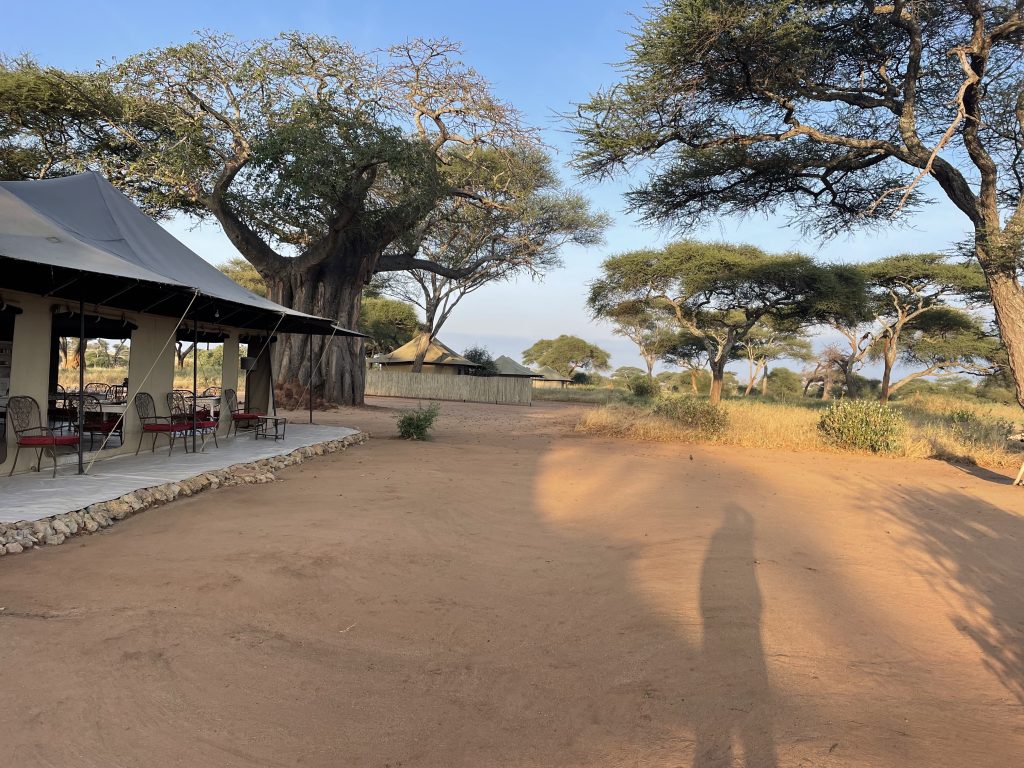
We chose to do four camps to see as many different places as we could. I am glad we did this because if you stayed in the same camp the entire time, you might be limited in what you see.
We started in Kenya in the Masai Mara National Reserve at Governors Il Moran Camp. This was so cool because down in the riverbed there were tons of Hippos. They make noises all night to scare off prey but it was awesome to be so close to them.
Next we crossed over to Tanzania and stayed at the Siringit Migration Camp in the Northern Serengeti. We literally had giraffe’s walking through our camp. It was amazing!
Our next camp was in Tarangire National Park at Lokisale Camp. This was the most rustic of our camps. We were in nylon tents (although the insides had fully equipped wooden bathrooms/showers) and we slept in cot beds. My most vivid memory of this camp was the lion killing prey right outside our tent. I was dying to see it but knew we could never unzip our tent in the pitch black with a lion right outside.
Then we went back to Kenya and ended our trip at the luxurious Finch Hattons resort in Tsavo West National Park.
What we loved about this itinerary is we saw all types of terrain and different animals in different environments. For me personally, I probably wouldn’t go back to Lokisale because it was so rustic and when the generator went out we had no internet for 24 hours (which made it hard to stay connected to our adult daughter who was at home working). It was glorious to end at Finch Hattons and be pampered for the last few days. I would probably do a similar itinerary with 2-3 nights at four different camps in different areas.
Every day is different of course but we liked the variety of so many different camps, parks, terrain, and animals. As the guides say, “We’ll see what we’ll see!”
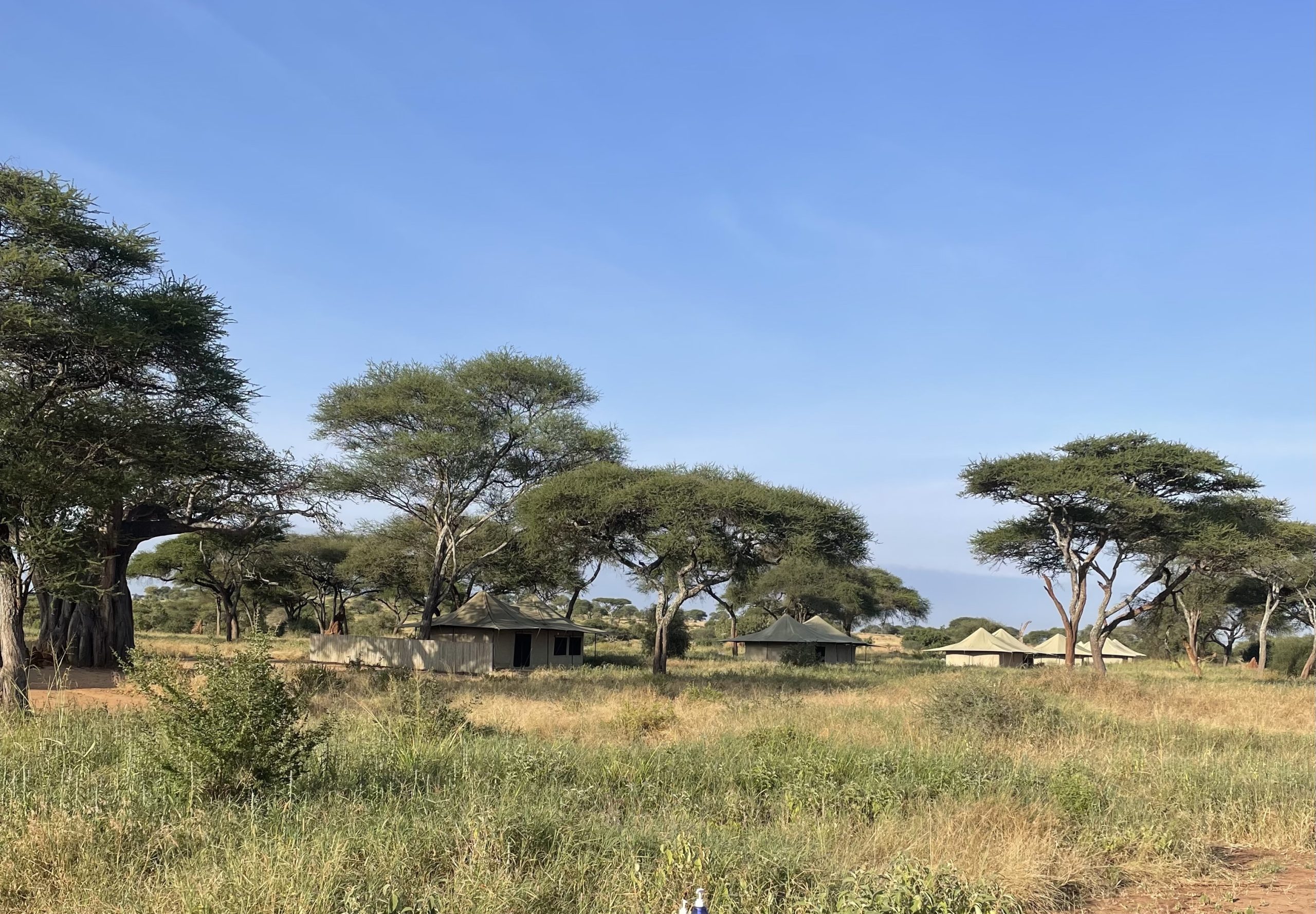
Note: The further out and rustic you are, the less Wi-Fi you’ll have. If this is important for you, consider camps closer to the cities than out in the middle of nowhere. Wi-Fi out there is usually run on generators so if the generator goes out, it takes a day to reset everything (this happened to us.)
What to Wear
I’ll provide a pdf checklist of what I brought. I feel I had a great mix and exactly enough for the entire trip. With the glamping camps, I did wear something a little nicer for dinner. For the rustic camp, I stayed in shorts and a pullover top in the evenings. Most camps have laundry services. It is important to find out if they have same-day or next-day in case you need something that evening.
***Ladies note – it is a cultural norm that they will not wash women’s undergarments so those you’ll have to load up on those.
The weather fluctuates so much from mornings/evenings to during the day, think layering.
Clothes – for 10 nights/11 days + two 20-hour travel days
Your clothes should be neutral colors, no brights. And, in some areas, camouflage is actually illegal so keep that at home.
Here is what I brought:
Underwear (have enough for the trip plus backup*)
2 bras – tan and black plus sticky boobs
4 tank tops
4 short sleeved casual shirts
3 pair of shorts
1 skort (I love a skort!)
4 pair of pull-on capris (3 would have been fine)
2 short sleeved button-up shirts (1 could be long sleeved)
1 nice pullover lightweight sweater
1 nice pullover sweatshirt type top
1 pair of leggings
1 bug sprayed pullover
1 regular pullover
2 pair of black low ankle socks
2 pair of tan ankle socks
Ankle “safari” boots
Tennis shoes
Wedge sandals (for dinners)
Flip flops
2 lightweight jackets (you could easily do one)
1 lightweight rain jacket
Hat (although I only wore it on 2 occasions when it rained a little)
Lightweight sweatpants for the plane
I didn’t bring the zip-off pants but could see how those would be useful as the morning and evenings were very chilly and the days were hot.
All our camps had robes so check before you pack that.
Other
Collapsible water bottle
Sunscreen – lotion will last longer than spray
Tiny bug spray (some camps had it and some didn’t so have it for backup)
Itch cream
Travel-size toiletries and skin care products* (get them as consolidated as possible)
Tiny magnifying mirror
Tums/Benadryl/Advil/Tylenol
Face wipes
Adapter
Curling or flat iron with 220 voltage. Don’t bring a 110 as you’ll blow it up.**
Small steamer with 220 voltage
Big hair clip(s) and or ponytail holders (if you have longer hair)
Bathing suit if your camp has a pool
Backup phone charger
Lip balm
Plugs (all our camps had USB ports)
One pair each of silver and gold hoops/earrings
Watch (If you have an Apple watch, bring one neutral band)***
Backpack
Small binoculars (bring bigger/better ones if you can fit them)
Sunglasses
Camera – my phone did amazing. We have a nice camera, so my husband brought that. But the new cell phones take incredible pictures.
*Some camps had soap in the rooms for washing undergarments
**All camps (even the rustic one) had shampoo and lotion but if you color your hair, you know what you need to bring. Also, some don’t have conditioner so bring a small one for sure.
***Every camp had a blow dryer so check that before you pack one
****BONUS – when you wear your Apple watch on safari because it’s so bumpy, you will close your rings and get upwards of 10,000 “steps” per day 😂
Currency
Everyone in Kenya and Tanzania took U.S. Dollars so we did not need to convert to Schillings. They also gave us change in U.S. Dollars
How to Pack
You must pack in a soft duffel bag (no wheels). We were fortunate that our tour company gifted them to us. The small planes will not take hard luggage. Our weight limitation was 15kg or 33lbs – TOTAL!!! That’s for a duffel and backpack.

Hint – your boots will be the heaviest thing in your bag, so where those on the plane and layer up if you need to.
With the laundry services available, packing light can be done. Trust me on this. I’m the gal whose suitcase is regularly at 52 lbs in the U.S. (with airline status you get a few extra pounds) and 69 lbs in Europe – LOL. This all being said, before I left, I read airports vary from 33-44 pounds so definitely verify with your tour company what your weight allotment is and pack accordingly – the larger airstrips do have scales.
Use packing cubes! With everything in a soft duffel, the cubes make it so easy. I put undergarments in one, short-sleeved shirts in one, shorts in one, pants in one, etc. This makes moving camp to camp super easy too.
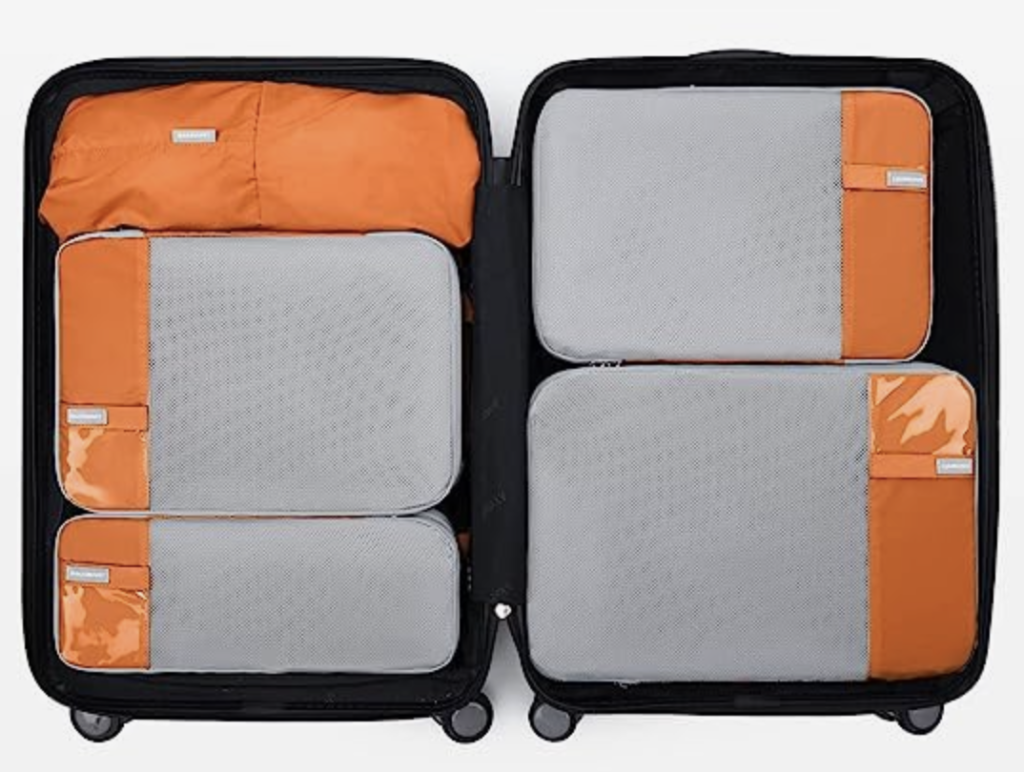
Checklist Download
Click HERE to download your checklist of what I brought
Food/Drink
In Africa, all the lodges served three (amazing) meals per day. If you’re like me though, at this point in my life I prefer to graze and eat six small meals/day. That was tough because I’d graze at breakfast and be hungry an hour later when we were on safari.
I was tempted to bring a big bag of Bud & Elsie’s popcorn (my favorite) and a small reusable bag or some mini Kind bars to pack a snack every day. Either is super light and would have done the trick.
One of our camps served popcorn at happy hour and I asked if they could send some along on our full-day safari the next day which was great. I probably should have asked the other camps what snacks they had that I could pack along
Our camps were all-inclusive and the wines were delicious. I’m a chardonnay girl and had not really experienced African wine before and I loved it. The camps had full bars, water, sodas, and juices so anything you could want was available.

I felt eating here was super healthy too (except for all the bread and dessert at lunch AND dinner but a few bites was fine). Soups are very popular, and they were served at almost every lunch and dinner. I cannot tell you how many amazing soups we had on this trip and things I never would have thought to put together like pea coconut soup – and I don’t really like coconut – it was delicious!
Breakfast is pretty much like ours in the U.S. and pretty consistent at all the camps – cereals or granola, fruit, bread, eggs, pancakes, crepes, bacon, and sausage.
Lunch and dinner were all delicious with a protein, starch (mainly rice), and tons of vegetables.
Every meal was a surprise and nothing disappointed. We also found that most camps offered a vegetarian option even without asking. If you have dietary restrictions, just make sure to tell the tour operator so they can let them know ahead of time and they will plan accordingly.
The Game Safari
Get ready for the experience of a lifetime!!! As I said, you’ll want a clip for your hair or hat because you are in an open-air vehicle and it’s windy. And it’s dusty! One tour guide said he had people who complained about the dust (seriously?) Just be prepared. And every camp has hot washcloths when you get back to wash the dust off.
Make sure your phone is charged and bring your extra battery. I literally took thousands of pictures and videos. You’ll also want to clear out your phone and/or make sure you have enough memory before you go.
Always Be on the Lookout!
Ask your guide what is popular in the area you’re in. Certain animals like tall grasses, and others like short grasses. Look for cats in tall grasses, on termite mounds and rocks, and in dense shady bush in the heat of the day. If you’re in a leopard area, ask your guide to show you a good leopard tree is and then look for a tail hanging down. These are tough to spot, and we got a one-in-a-million view of a leopard scaling down a tree with prey in her mouth. WARNING: Video is a little graphic but very cool:
What we learned by the end of our trip is that cats are very elusive and hard to find. You’ll have a bit more luck with lions because they travel in prides and stay in a certain area. We were lucky to see a cheetah, leopard, and multiple lion sightings on this trip. (There are no tigers in Africa.)

As I mentioned above, most safaris are early in the morning, around 6:30 am, back for lunch and rest, and then back out around 3:30-4:30. We also did one full-day safari and saw a lot, so it was just as good as the two half-day ones. Trust your guide.
The key to your safari is your guide! You really want a seasoned guide, and I would insist on it. When we saw the leopard, a young guide was driving a group right in front of us and our guide said, “OMG, he missed the leopard! He missed the leopard!” The good news is when there is a sighting, they are all on phones or radio to share with others. This will be a huge downside in the high season. In June it could mean 5 vehicles. In peak time it could be 100s. We shared our “finds” and were thankful when other groups did the same for us!
The sunsets are spectacular! Enjoy those when you return to camp.

Suggested Tipping
This is where we really needed help from our tour operator and appreciated the guidance. This is what they gave us that we followed:
- Host at arrival destination $5-$10/person per day
- Guide on Safari $10-$15/person per day
- Tracker on Safari $5-$10/person per day
- Roo Butler (if you have one) $5-$10/person per day
- Lodge Staff (is split among the entire staff) $5-$10/per person (in your group not employees) per day
- Spa Services – 10%-15%
What it Cost
We did a custom safari, not in a group, that had everything included, one-night hotel stay in Nairobi, transportation to all camps – vehicles and airplanes (minus airfare to/from Nairobi), room, 3 meals/day, beverages, alcoholic beverages, safari guides.
A trip like this runs about $15,000/person for 10 nights and 11 days (excluding airfare).
There are less expensive versions available. This is just to compare what we did as I described above.
Before You Go:
Tribes: I wish I had known about all of the African tribes prior to arriving in Kenya, particularly the Maasai. In two weeks, I have learned so much but I would have had better conversations with them had I known some history and understanding of their culture. If Kenya is on the list, learn about the various tribes in the area.
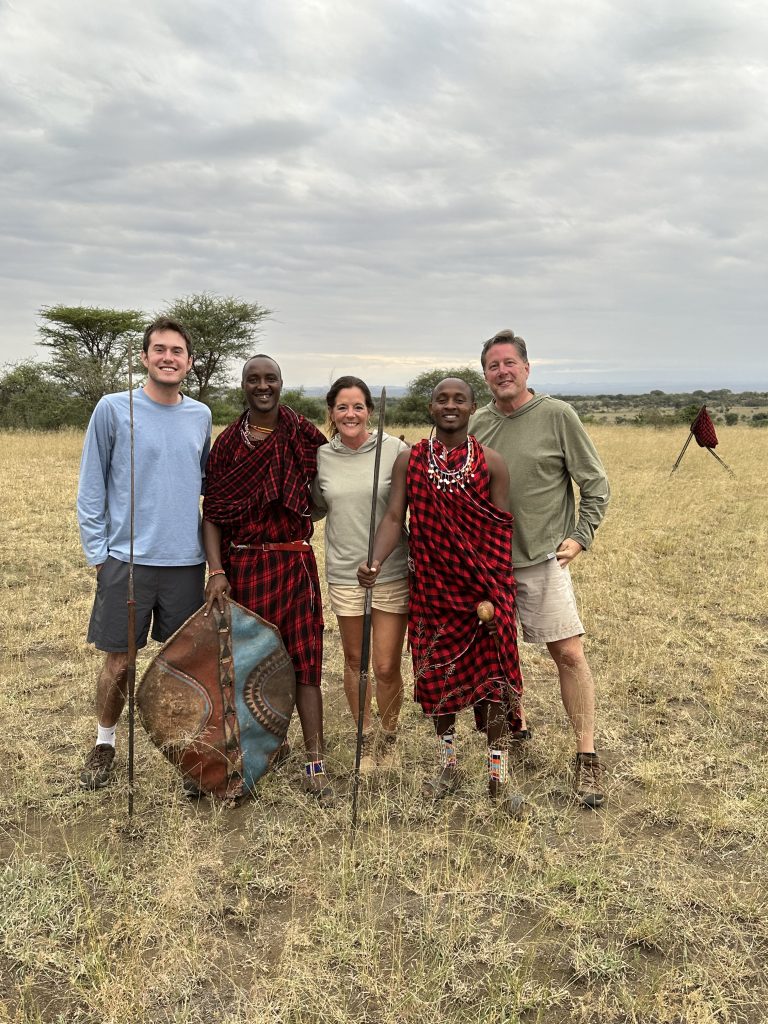
The Kenyan people were the kindest, happiest people I’ve ever met. They just have so much joy in their hearts and pride for their country. When we were driving through the villages or on our last day in Nairobi, the kids loved seeing us and would wave like crazy. In this picture, we were stopped and they lined up to shake our hands and talk to us.

Words:
Here are a few words to bring with you when you go. Say Jambo and you will get an immediate smile from everyone!
Jambo – Hello, Greetings
Asante – Thank you
Asante Sana – Thank you so much
Karibu – Welcome and You’re Welcome
Kwa afya – Cheers
___________________
If this is on your bucket list and doable, do it!!!
Here are my main suggestions summed up:
- Use a seasoned travel agent (Jen at Destinations Done Right will take amazing care of you).
- Ask specific questions regarding your specific needs (sleeping arrangements/family quarters, dietary restrictions, anything special you want or need).
- Get a seasoned guide! I cannot stress this enough. I’ve heard so many people who went on safari and saw nothing.
- Pack light with mix & match outfits and wear your boots on all the small flights. Download the check list.
- Write out your itinerary. It gets very confusing with transfers and flights if you are moving camps.
- Charge your phone and bring a backup battery
- Enjoy every minute!
Learn more at www.LivingAgelessandBold.com and check out the podcast below:



